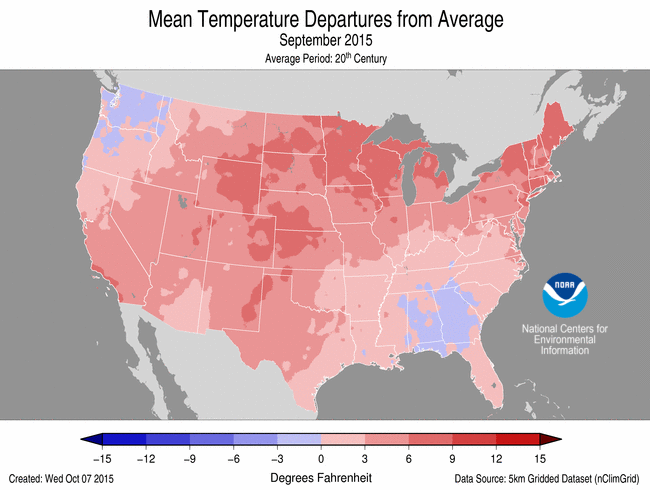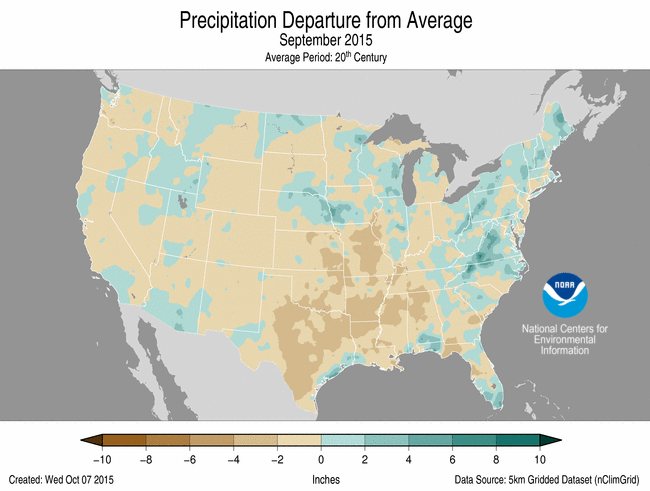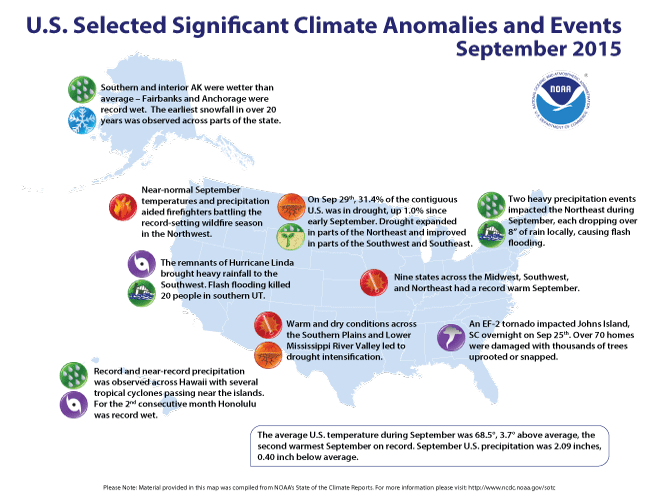Monthly Report Summary Information
The Monthly Report Summary Information is a synopsis of the collection of national and global summaries released each month.
National Summary Information - September 2015
See Full Report
For extended analysis of regional temperature and precipitation patterns,as well as extreme events, please see our full report that will be released on October 14th.
September 2015 was second warmest for contiguous US
First nine months of 2015 were the
eighth warmest on record for the Lower 48
The September contiguous U.S. average temperature was 68.5°F, 3.7°F above the 20th century average. Only September 1998 was warmer for the Lower 48. Record and near-record warmth spanned most of the country, with nine states in the Northeast, Midwest, and Southwest record warm. The September precipitation total for the contiguous U.S. was 2.09 inches, 0.40 inch below average and the 21st driest on record.
This analysis of U.S. temperature and precipitation is based on data back to January 1895, resulting in 121 years of data.
U.S. climate highlights: September
Temperature


September 2015 Temperature Departure from Average
(top) and Precipitation Departure from Average (bottom)
- Record and near-record warmth was observed across most of the country. Thirty states had September temperatures that were much above average and nine states — Connecticut, Colorado, Maine, Michigan, Minnesota, New Mexico, Rhode Island, Utah, and Wisconsin — were record warm.
- Near-average September temperatures were observed in the Southeast and in the Northwest. The near-average temperatures in the Northwest were a reprieve from the record warm summer (June-August) and aided firefighters battling the record-breaking wildfires in the region. Alaska was cooler than average during September.
Precipitation
- Above-average precipitation was observed for parts of the Midwest, Mid-Atlantic, and Northeast. Below-average precipitation was observed across the Central Rockies, Southern Plains, and the Lower Mississippi River Valley. Arkansas had its 11th driest September on record.
- According to the September 29th U.S. Drought Monitor report, 31.4 percent of the contiguous U.S. was in drought, up about 1.0 percent compared to September 1st. Drought conditions improved across parts of the Southwest and Southeast, particularly in South Florida. Drought conditions worsened across parts of the Northeast. In the Southern Plains and Lower Mississippi River Valley, Extreme Drought (D3) expanded due to the warm and dry month. Precipitation was spotty across the West with long-term drought conditions continuing to plague the region.
- Outside of the contiguous U.S., drought improved in Alaska which was wetter than average in September. Drought also improved in Hawaii where tropical cyclones passed near the Islands. Drought improved in central Puerto Rico, but Severe and Extreme Drought (D2-D3) continued across the eastern third of the island.
U.S. climate highlights: Year-to-date (January-September)
Temperature


Jan-Aug 2015 Temperature Departure from Average (top)
and Precipitation Departure from Average (bottom)
- The year-to-date contiguous U.S average temperature was 56.9°F, 1.9°F above the 20th century average, the eighth warmest on record. This was also the warmest year-to-date since 2012. Above-average temperatures were observed in the West and Southeast. Overall, 13 states, including Alaska, were much warmer than average. California, Nevada, Oregon, and Washington were each record warm with temperatures more than 4.0°F above the 20th century average. Below-average temperatures were observed in the Midwest and Northeast.
Precipitation
- The year-to-date precipitation total for the contiguous U.S. was 24.23 inches, 1.03 inches above the 20th century average, and the 32nd wettest on record. Above-average precipitation was observed across the central US, where Kentucky, New Mexico, Oklahoma, and Texas were much wetter than average. No state was record wet for the year-to-date.
- Below-average precipitation was observed along both coasts. California, Connecticut, and Oregon each had precipitation totals that were much below average. California had its fourth driest year-to-date receiving about half its average precipitation.
Extremes
- The U.S. Climate Extremes Indes (USCEI) for the year-to-date was 25 percent above average and the 23rd highest value on record. On the national scale, extremes in warm maximum and minimum temperatures, one-day precipitation totals, and days with precipitation were much above average. The USCEI is an index that tracks extremes (falling in the upper or lower 10 percent of the record) in temperature, precipitation, land-falling tropical cyclones, and drought across the contiguous United States.
For extended analysis of regional temperature and precipitation patterns, as well as extreme events, please see our full report that will be released on October 15th.
 NOAA's National Centers for Environmental Information
NOAA's National Centers for Environmental Information
